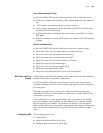126 CHAPTER 5: IP ROUTING PROTOCOL OPERATION
BGP runs on a router in any of the following modes:
■ Internal BGP (IBGP)
■ External BGP (EBGP)
BGP is called IBGP when it runs within an AS and EBGP when it runs among
different ASs.
Configuring BGP is described in the following sections:
■ BGP Messages
■ BGP Routing
■ BGP Peers and Peer Groups
■ Configuring BGP
■ Typical BGP Configuration Examples
■ Troubleshooting BGP
BGP Messages BGP is driven by the following types of messages:
■ Open — Sent after a connection is created between BGP peers.
■ Update — Used to exchange routing information between peers. This message
has up to three parts
■ Unreachable route
■ Path attributes
■ Network layer reachability information (NLRI).
■ Notification — Used for error notification.
■ Keepalive — Used to check connectivity to peers.
■ Route-refresh — Used to advertise its own route refreshing capability.
The open, update, notification and keepalive messages are defined in RFC1771,
while the route-refresh message is defined in RFC2918 (Route Refresh Capability
for BGP-4).
BGP Routing At startup of the BGP session, the BGP router exchanges routing information with
its peers by transmitting the complete BGP routing table. After that, only update
messages are exchanged. During operation of the system, keepalive messages are
received and transmitted to check the connections between various neighbors.
The router transmitting BGP messages is called a BGP speaker, which receives and
generates new routing information continuously and advertises the information to
the other BGP speakers. When a BGP speaker receives a new route advertisement
from another AS, it will advertise the route to all other BGP speakers in the AS, if
the route is better than the current route, or is a new route.
A BGP speaker calls other BGP speakers peers. Multiple related peers compose a
peer group.


















